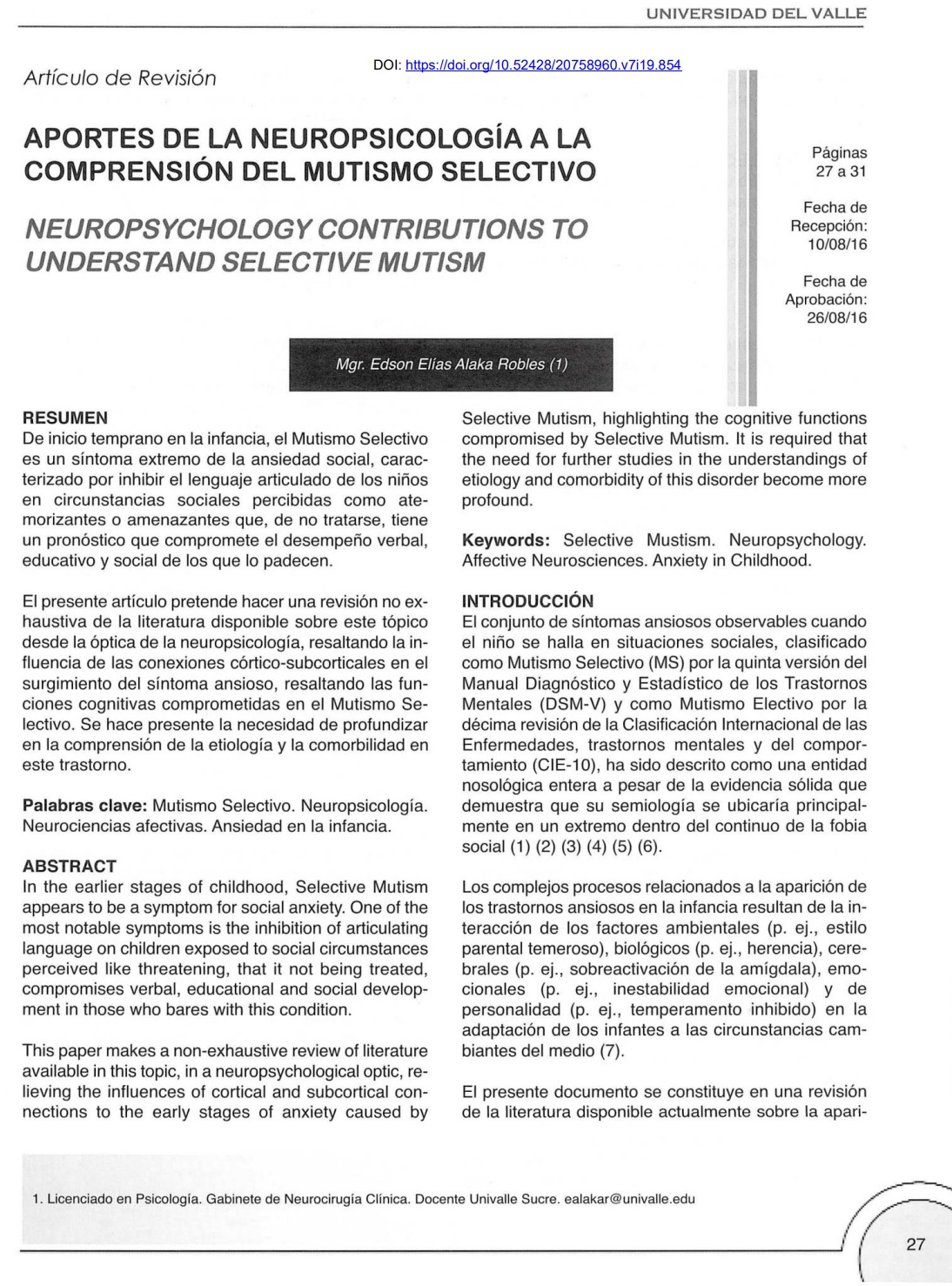Neuropsychology Contributions to Understand Selective Mutism
DOI:
https://doi.org/10.52428/20758960.v7i19.854Keywords:
Selective Mustism, Neuropsychology, Affective Neurosciences, Anxiety in ChildhoodAbstract
In the earlier stages of childhood, Selective Mutism appears to be a symptom far social anxiety. One of the most notable symptoms is the inhibition of articulating language on children exposed to social circumstances perceived like threatening, that it not being treated, compromises verbal, educational and social development in those who bares with this condition. This paper makes a nonexhaustive review of literature available in this tapie, in a neuropsychological optic, relieving the influences of cortical and subcortical connections to the early stages of anxiety caused by Selective Mutism, highlighting the cognitive functions compromised by Selective Mutism. lt is required that the need far further studies in the understandings of etiology and comorbidity of this disorder become more profaund.
Downloads
References
BLACK, B., & UHDE, TW. (1992). Elective mutismas a variant of social phobia. Journal of the American Academy of Child and Adolescent Psychiatry 31:1090-1094. PMid:1342579 https://doi.org/10.1097/00004583-199211000-00015
BLACK, B., & UHDE, TW. (1994). Treatment of elective mutismwith fluoxetine: a double-blind, placebo controlled study. Journal of the American Academy of Child and Adolescent Psychiatry 33:1000-1006. PMid:7961338
https://doi.org/10.1097/00004583-199409000-00010
DOW, S. P., SONIES, B. C., SCHEIB, D., MOSS, S. E., & LEONARD, H. L. (1995). Practica! guidelines for the assessment and treatment of selective mutism. Journal of the American Academy of Child and Adolescent Psychiatry 34:836-846. PMid:7649953 https://doi.org/10.1097/00004583-199507000-00006
ANSTENDIG, K. D. (1999). Is selective mutism an anxiety disorder? Rethinking its DSM-IV classification. Journal of Anxiety Disorders 13:417-434. PMid:10504110 https://doi.org/10.1016/S0887-6185(99)00012-2
GARCIA, A. M., FREEMAN, J. B., FRANCIS, G., MILLER, L. M., & LEONARD, H. L. (2004). Selective mutism. En T. H. Ollendick, & J. S. March (Eds.), Phobic and anxiety disorders in children and adolescents: A clinician's guide to effective psychosocial and pharmacological interventions (pp. 433-455). New York, NY:Oxford University Press.
https://doi.org/10.1093/med:psych/9780195135947.003.0015
BEIDEL, D. C., & TURNER, S. M. (2005). Childhood anxiety disorders: A guide to research and treatment. New York, NY:Taylor & Francis Group.
GARZA, N. (2012). Aproximación al Mutismo Selectivo desde la Psicoterapia lntegrativa Infante Juvenil. AcPI 4:39-75.
GARCIA-MOLINA, A.; ENSENAT-CANTALLOPS, A.; TIRAPU-USTARROZ, J. & RORG-ROVIRA, T. (2009). Maduración de la corteza prefrontal y desarrollo de las funciones ejecutivas durante los primeros cinco años de vida. Rev. Neurol. 48:435-40. PMid:19340785 https://doi.org/10.33588/rn.4808.2008265
KOLVIN, l., & FUNDUDIS, T. (1981 ). Elective mute children: Psychological development and background factors. Journal of Child Psychology and Psychiatry 22:219-232. PMid:6167589 https://doi.org/10.1111/j.1469-7610.1981.tb00548.x
KRISTENSEN, H. (2000). Selective mutism and comorbiditywith developmentaldisorder/delay,anxiety disorder, and elimination disorder. Journal of the American Academy of Child and Adolescent Psychiatry 39:249-256. PMid:10673837 https://doi.org/10.1097/00004583-200002000-00026
STEINHAUSEN, HC., & JUZI, C. (1996). Elective mutism: An analysis of 100 cases. Journal of the American Academy of Child and Adolescent Psychiatry 35:606•614. PMid:8935207 https://doi.org/10.1097/00004583-199605000-00015
KRISTENSEN, H. & OERBECK, B. (2006). Is selective Mutism associated with deficits in Memory Span and Visual Memory? An exploratory case•control study. Depression and Anxiety 23:71•76. PMid:20140 https://doi.org/76.10/da.1002 https://doi.org/10.1002/da.20140
VIEILLARD, S. & HARM, J. (2013). La régulation des émotions au cours du vieillissement normal Revue critique. Année psychologique 113:4. https://doi.org/10.4074/S000350331301405x
BEAUREGARD, M., LEVESQUE, J., & PAQUE• TIE, V. (2004). Neural basis of conscious and volun• tary self•regulation of emotion. En M. Beauregard (Ed.), Consciousness, Emotional Self•Regulation and the Brain (pp. 163•194). Montréal: Johns Benjamins Publishing Company. https://doi.org/194.10/aicr.1075.54bea https://doi.org/10.1075/aicr.54.08bea
MANASSIS K.; FUNG D.; TANNOCK, R.; SLOMAN, L.; FIKSENBAUM, L. & MCINNES, A. (2003). Characterizing selective mutism: Is it more than social anxiety? Depress Anxiety 18:153•161. PMid:10125 https://doi.org/161.10/da.1002 https://doi.org/10.1002/da.10125
OEBECK, B. & KRISTENSEN, H. (2008). Attention in selective mutism An exploratory case•control study. Journal of Anxiety Disorders 22:548•554. PMid:008 https://doi.org/554.10/j.janxdis.1016.2007.04
https://doi.org/10.1016/j.janxdis.2007.04.008
• ASOCIACIÓN AMERICANA DE PSIQUIATRÍA (2014). DSM•5. Manual diagnóstico y estadístico de los trastornos mentales. Madrid: Editorial Médica Panamericana.
• ORGANIZACIÓN MUNDIAL DE LA SALUD. (1992). CIE 10. Décima revisión de la clasificación Internacional de las enfermedades, trastornos mentales y del comportamiento: Descripciones clínicas y pautas para el diagnóstico. Madrid: Meditar.
• VIANA, A.; BEIDEL, D. & RABIAN, B. (2009). Selective Mutism: A review & integration of the last 15 years.Clinical Psychology Review 57•67. PMid:009 https://doi.org/67.10/j.cpr.1016.2008.09 https://doi.org/10.1016/j.cpr.2008.09.009

Downloads
Published
How to Cite
Issue
Section
License
Copyright (c) 2016 Edson Elías Alaka Robles

This work is licensed under a Creative Commons Attribution 4.0 International License.
Authors who publish with this journal agree to the following terms:
- Authors retain copyright and grant the journal right of first publication with the work simultaneously licensed under a Creative Commons Attribution License 4.0 that allows others to share the work with an acknowledgement of the work's authorship and initial publication in this journal.
- Authors are able to enter into separate, additional contractual arrangements for the non-exclusive distribution of the journal's published version of the work (e.g., post it to an institutional repository or publish it in a book), with an acknowledgement of its initial publication in this journal.
- Authors are permitted and encouraged to post their work online (e.g., in institutional repositories or on their website) prior to and during the submission process, as it can lead to productive exchanges, as well as earlier and greater citation of published work.









